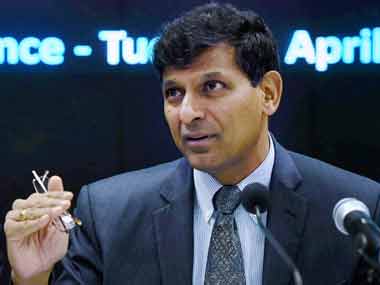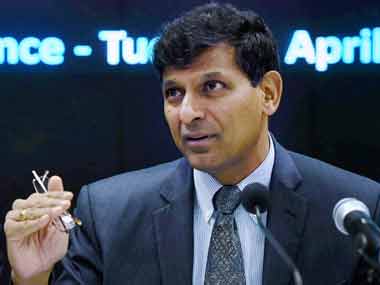Every other economist you talk to would caution you to take India’s GDP (gross domestic product) numbers with a pinch of salt. That has been so for a year since the Narendra Modi government introduced new measure to count the GDP (based on Gross Value Added (GVA) method instead of the earlier one based on factor cost) and changed the base year of GDP calculation to 2011-12 from 2004-05. Reserve Bank of India (RBI) governor Raghuram Rajan has now joined this group, raising questions about the GDP numbers. [caption id=“attachment_2558186” align=“alignleft” width=“380”]  RBI governor Raghuram Rajan. PTI[/caption] “There are problems with the way we count GDP, which is why we need to be careful sometimes just talking about growth," Rajan on Thursday said in his address at the 13th convocation at Indira Gandhi Institute of Development Research. The new method of GDP instantly lifted the country’s GDP growth to 7.3 percent in fiscal year 2015 compared with 5.5 per cent under the old series. For the Modi government, the higher GDP number was euphoric to support its claims that the economy has indeed turned the corner to the high-growth trajectory, becoming world’s fastest growing major economy even beating China’s growth rate (though the size of Chinese economy is five times more than that of India.) But the ‘skeptics’, who would hesitate to go with the Modi camp’s euphoria, kept cautioning about the protruding disconnect between the new set of GDP numbers and high frequency macro-economic indicators in the economy. These included bank credit growth, corporate performance, auto sales, factory output and growth in the manufacturing sector that should ideally correlate with the GDP figure. Even while accepting that the fresh GDP calculation methodology is in line with international practice, they questioned the actual growth rate of the economy and the picture depicted by the new set of numbers. To explain his argument, Rajan took the example of two mothers who babysit each other’s child instead of their own and exchange money as charges. “There is a rise in economic activity as each pays the other, but the net effect on the economy is questionable,” said Rajan. “We should be careful about how we count. Obviously lots of people have thought how to improve our counting of GDP and going forward that is something that we will have to think about," the governor added. The comments, coming from a world-renowned economist and the head of country’s central bank, are indeed serious enough and should be taken note by the Modi-government. The fact is that there are serious concerns on growth on the ground. There are a few reasons that tell us why the high GDP numbers aren’t mirroring the actual situation on ground. One, a highly stressed banking sector and tepid credit growth do not reflect a fast growing, strong economy. Total stressed assets (bad and restructured assets) in the banking sector has risen to 12 per cent of the total bank loans, while gross NPAs of the banking sector, as a percentage of total loans, could reach 5.4% by September 2016, according to the RBI’s financial stability report (FSR) from 5.1% in September 2015. Clearly, the health of the banking sector doesn’t look good so far. This is also indicated by the December quarter earnings of ICICI bank, which has reported a spike in gross NPAs to 4.72 per cent from 3.77 per cent in the preceding quarter, indicating that bad loan worries aren’t over for the industry yet. Stress in the banking sector has resulted in lower credit flow to productive sectors. Going by the latest RBI data, bank lending to industries has grown by 4.6 percent in the 12 months till October 2015 compared with 7.8 percent in the corresponding period in the previous year. In the March-October period of the current fiscal year, credit growth to industries has languished at negative 0.3 percent compared with 0.7 percent in the previous year. The worst hit has been medium-sized companies, where bank lending has contracted by 10.9 percent as against a contraction of 1.1 per cent in the same period last year. According to analysts, there is more pain left in the banking sector as a significant chunk of the restructured assets will turn bad in the absence of major pick up in the economic scenario. Two, manufacturing growth has been tepid. The tepid growth in factory output, also reflected in the core sector growth (fell 1.3 percent in November) and monthly PMI data (to 49.1 from 50.3 in November) indicate that revival in manufacturing activity has remained elusive. The growth in the manufacturing sector till November this fiscal year has averaged at 3.9 per cent compared with 2.3 per cent in the previous fiscal, which signals some improvement in the economy but not a sharp jump. The sharp contraction in the November IIP number to a four-year low of negative 3.2 percent, (though partly due to seasonal factors) a visible drop in capital goods production and sequential contraction in most of the manufactured products sub-components have raised doubts among economists on the durability of the recent robustness in the industrial output. Three, corporate earnings have been muted so far and hasn’t shown any significant revival yet. This is evident from the profit and revenues growth of companies reported earnings in the September quarter and those companies reported earnings so far in the December quarter stood. The over-leveraged corporates are experiencing further pressure on their cash flows on account of prolonged economic slowdown. A recent note from rating agency Crisil forecast corporate earnings to grow by mere 2 percent in the three months ending December compared with 5 percent in the corresponding period in the previous fiscal year on account of plunging commodity prices coupled with weak investments in the economy. Four, although there is an improvement in the car sales in recent quarters, the two-wheeler sales have tumbled. In the December quarter, the two-wheeler sales have shown a decline. This indicates tepid consumer demand. Five, rural demand continues to be weak as evident from the earnings of companies like HUL, which were below analysts’ expectations with a 22 per cent decline in net profit at Rs 971 crore in the third quarter ended December 31, 2015, as compared to Rs 1,252 crore in the corresponding three months of the previous fiscal. Sixth, India has been facing massive contraction on the export-front. The country’s exports have shrunk for the 13 consecutive month in a row. It fell by 18% during April-December 2015 from the same period year ago. As Firstpost has noted before, one of the major factors that benefited the Modi government in the past year was the crash in oil prices, which helped lessen the burden on import bill and the inflation. But, except this, there has not been any marked improvement in the growth triggers in the domestic market regardless of what the GDP number shows. This is probably the reason that prompted Rajan to question the new methodology to calculate the GDP numbers. Clearly, it is time for the Modi government to pay attention to the ‘skeptics’ and look at the economy in a more realistic manner. Data contributed by Kishor Kadam
Clearly, it is time for the Modi government to pay attention to the skeptics and look at the economy in a more realistic manner
Advertisement
End of Article


)

)
)
)
)
)
)
)
)



